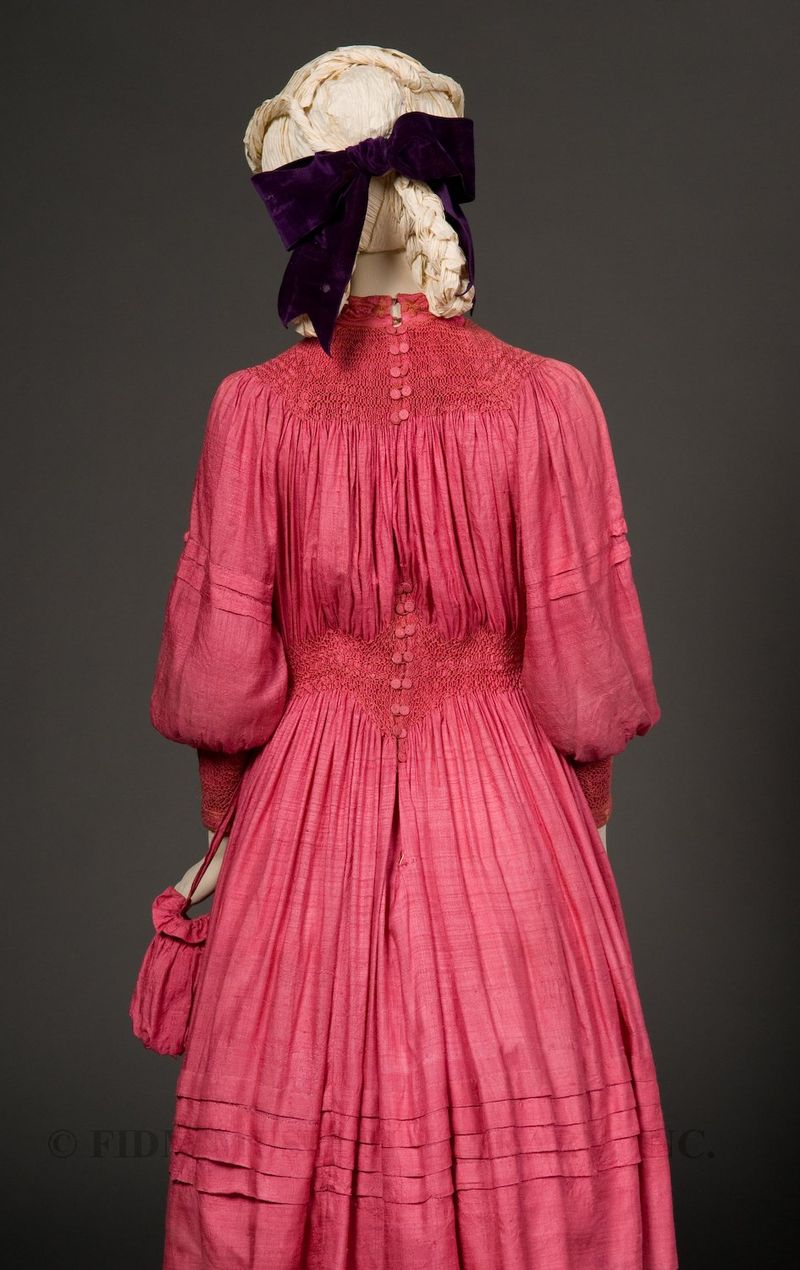Between the 1750s and the late 19th century, rural Englishmen wore voluminous smocks when working outdoors. Usually made of rough homespun, most smocks had long, full sleeves and ended at mid-calf. Though entirely functional, smocks often featured decorative embroidery around the cuffs, bodice or neckline. Called smocking, it was more than mere decorative embellishment. Because smocking consisted of stitches passed over areas of gathered fabric, it created stretch in an otherwise non-stretch garment, allowing for more freedom of movement. This was important for those living in rural areas, as manual labor was an undeniable fact of life.
In what could be considered an early example of work-wear influencing fashion, both smocks and smocking became an important part of fashionable dress beginning in the 1870s. Smocks were adopted by those artists and bohemians interested in alternative styles of dress. Decorative smocking appeared on garments worn by women and children, such as the young girl’s day dress of pink silk seen below. Here, smocking stitches create the bodice, peaked waistline and fitted cuffs.
 Day dress
Day dress
Attributed to Liberty & Company, London
c.1893-97
Museum Purchase
2008.25.3
Ironically, both smocks and smocking became popular among urbanites just as these sartorial traditions were losing ground among villagers. In rural areas, people were more interested in wearing garments associated with an urban lifestyle, such as tailored suits. From the perspective of those living in bustling, crowded industrial cities such as London, the supposed tranquility and perceived innocence of rural life and its traditions was extremely appealing. By clothing themselves in garments suggestive of a rural lifestyle, urbanites created an romanticized version of the countryside in the midst of modern, industrial life.
 Back view of 2008.25 Notice the attached pouch purse at the left hip.
Back view of 2008.25 Notice the attached pouch purse at the left hip.
Because of its association with innocence, smocking was thought especially appropriate for children’s clothing. The illustrations of Kate Greenaway (1846-1901) were instrumental in promoting idealized rural dress for children in general and girls in particular. Greenaway’s illustrations drew on historic costume sources, as well as her own experiences as a child in rural England. Wildly popular throughout the 1880s, Greenaway’s images of apple-cheeked girls and boys frolicking in the English countryside influenced fashionable dress for children well into the 20th century. Between 1902 and 1912, Liberty & Company of London produced a “Kate Greenaway” line of “picturesque and fashionable dress” which drew on Greenaway’s illustrations for inspiration. For illustrations of Greenaway children wearing smocked garments, click here and here.
Baines, Barbara. Fashion Revivals: From the Elizabethan Age to the Present Day. Anchor Press: London. 1981.



Great post, smocking is a new topic for me. But doesn’t this dress look Edwardian, not 1890s?
Hi Alaina,
Dating Liberty garments can be tricky because the company re-used silhouettes and design motifs throughout the late nineteenth and early twentieth centuries. The curatorial staff dated this garment to 1893-7 primarily due to its construction techniques. During the 1890s, Liberty employed twill tapes sewn inside the bodice to control the smocking and bust fullness. We compared this dress with its inner tapes to an 1890s Liberty blouse and the construction technique was identical. The sleeves, with their elongated fullness, are very 1890s for Liberty. The saturated, bright pink color is more in line with an 1890s aesthetic than an Edwardian one, when Liberty tended to use more pastels. We are unaware of any published, comprehensive studies of Liberty of London garments and would love to learn more-do you have any recommendations?
Kate Greenaway…sigh. LOVE her drawings. Now when I see them, I will look for smocking!
Becky, be sure to check archive.org for Kate Greenaway illustrations. They have many of her books scanned into their site. It’s different than actually holding them in your hand, but still very interesting!
Hi, I’m curious about the construction of this garment as all the seam lines seem to be extremely well- hidden. How would a garment such as this have been constructed and at what stage in the process would the smocking have been added?